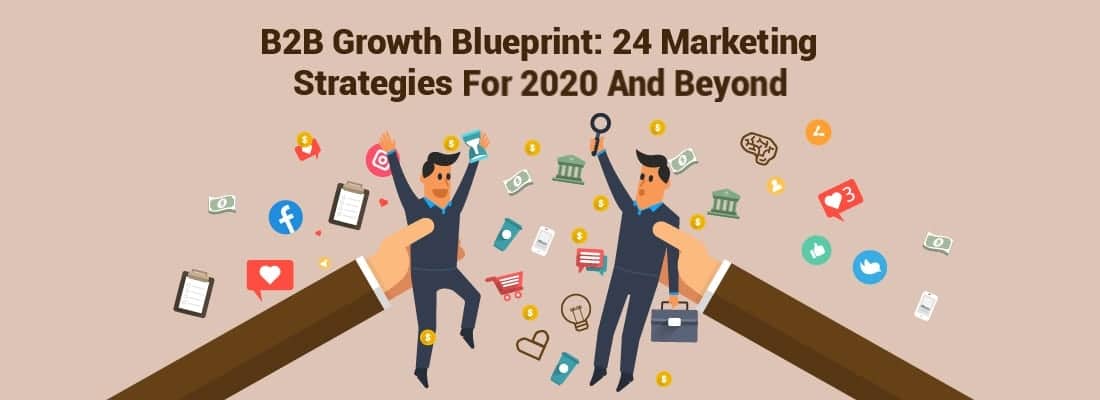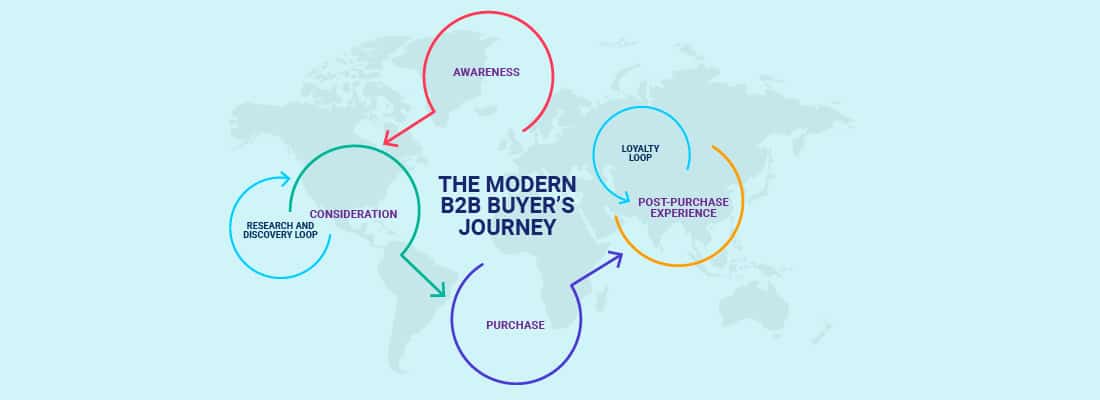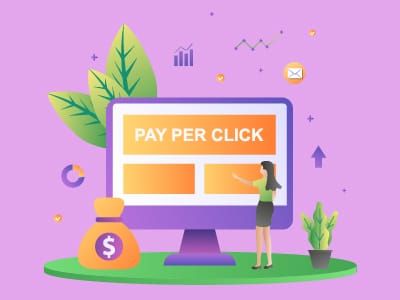
Introduction
We’re all constantly being told that B2B marketing is changing and that we need new marketing strategies to cope with this. We’re being told that the modern buyer doesn’t respond well to the B2B sales funnels of old and their buying habits are so mysterious you’re going to need a crystal ball or psychic octopus to continue to operate in the field.
Is this true?
It is true that the B2B market has changed in recent years, but the modern B2B buyers’ new habits aren’t as mysterious as some would have you believe. These buying habits might even be familiar to those of you with a little B2C business knowledge…
With a robust marketing framework, made up of the right marketing strategies you will not struggle to see growth in the B2B industry despite the change it’s gone through.
In this ultimate guide to marketing for B2B growth in 2020 and beyond we have broken down all the myths surrounding the new B2B buyer, talked you through how to put together a foolproof marketing plan, and have put together a guide to 24 of the best B2B marketing strategies for 2020 and beyond.
The Modern B2B Buyer’s Journey For Potential Customers

Before jumping into the marketing strategies we need to discuss the best way to approach B2B sales in and after 2020.
There isn’t a part of our lives that hasn’t been irreparably changed by the internet – this includes how the B2B industry functions. This isn’t a bad thing at all, but it does, however, require a change in mindset to thrive in this new frontier.
Making this change, however, will open up your business to a whole new world of leads and opportunities.
So what’s changed? Almost everything – from who’s ‘shopping’ to how they ‘shop’; and their journey from awareness to purchase:
The Buyer = we’re now seeing that over half of the B2B buyers are aged 18-30. This age group has grown up on the internet and approaches all areas of business with a different attitude.
Their Approach = cold calls are quickly becoming a thing of the past. The new Buyer will actively avoid cold calling. This new Buyer likes to be informed. More than two-thirds of their buying process is completed before they approach a seller.
They act like B2C customers and want to be treated like one too. 80% of B2B buyers admit to making their choices based on the quality of the seller’s customer service.
Before you approach them you should have done your research. You should also develop an attractive online presence that will allow the new Buyer to get to know you before approaching you, or do follow up research having spoken to you.
It is important to remember that the new Buyer tends to actually be multiple people making the choice. Your interaction with the buyer(s) and marketing plan should accommodate for this.
Their Journey = Once you have engaged with the buyer you will begin to very quickly notice that the traditional sales funnel no longer applied to the modern buyer. They may skip steps, they may loop back around and repeat steps too.
Although the steps of awareness, consideration, discovery, purchase, and loyalty aren’t dissimilar to the old process, they fit together in a new way for the modern buyer. This process will also be different for every customer most likely.
A Framework To Guide Your Marketing Strategy

Now that we have a clear idea about the modern B2B customer expects from you as a B2B supplier – it’s time to put together a framework for your marketing strategies.
Here’s some good news – with B2B buyers adopting the mindset of B2C buyers you can repurpose some tried and true B2C sales techniques to help you out along the way.
Avinash Kaushik’s ‘See, Think, Do, Care’ system is a perfect example of this.
Fitting each of your marketing strategies into one of these categories will help you to produce focused and efficient marketing that your business will see rewards from.
For a full explanation from Kaushik, watch one of his presentations here.
(This video does contain swearing and mild sexual jokes – however, we highly recommend it for all of you).
Categorizing your marketing strategies will force you to become intimate with the function and purpose of each of your strategies. This will give you the peace of mind that you are using your resources as effectively as possible.
Approach these categories as problems to solve. Use your marketing strategies to help you solve them. Kaushik designed this system specifically for online sales. It is a deviation from what he calls the ‘selfish business models of the past’ to something more customer-centric. It encourages businesses to look inwards as well as looking out.
Each category represents a different group of people you should be marketing towards.
Let’s categorize these groups, using Kaushik’s own example – a hotel.
See – If you were a hotel this would be the people who are old enough to stay, who want adventure, and who have money
Think – This group would include the people from above who are looking to book a hotel at some point – be it in in 5 minutes or in 2 years
Do – This group is people from the above two groups that want to book a room right now
Care – This would cover guests that have stayed with you more than once – i.e. they have made a deliberate choice to return to your hotel
(Remember for the modern buyer the care stage is what they are most concerned about.)
You should take some time to work out where your marketing strategies fit into this framework. For example, email lists make great care tools, and paid search engine advertisements are perfect Do strategies.
Customer Need States You Must Fulfill

There are six main need states that customers go through before they are ready to complete, your role is to help them do this:
- Identify their problem (why they need your product)
- Help them find a solution for their problem (your product)
- Discover their requirements (how your product can help them)
- Choosing the right supplier (you, what makes you different, and more importantly, better)
- The Solution (providing them with your product)
- Retaining their loyalty (keep them coming back)
The good news is that a well-rounded, thought out marketing strategy (using See, Think, Do, Care) will cover all these areas and leave you with a collection of loyal customers who love your company and choose to return to you time after time.
The Lowdown: 24 Strategies & Channels To Market Your Brand

Finally, we’ve reached the all-important marketing strategies. Here are a few pieces of information you must gather to make the most of their strategies:
- Who your competitors are
- Who your target audience is
- What your brand voice is
- What your brand stands for (outside of your product)
- Where your target market shops
- Where your target market spends their time online
- What your area of expertise is
Our final tip is to make sure you are actively tracking and evaluating the impact that these strategies have for you. This way you will be able to put your energy, resources, and focus into the right area.
Content Marketing

Content Marketing is a great way to establish yourself as leading experts and innovators in your field without having to spend a lot of money. Being able to prove to B2B buyers that you understand your field and that you can prove your success within is infinitely valuable in the modern market.
Here are 5 effective content marketing strategies:
White Papers

You should be using your business’s white papers to inform and convince your buyers that the product you provide is a superior market leader.
There are three main types of B2B white papers:
Backgrounders – this should explain the technical elements of what you have to offer
Numbers Lists – this should provide statistical evidence of the benefits of your product, as well as offering tips and pointers towards being successful in your field
Problem/Solution – in this you should put forward your solution to a common problem in your field. This is a great opportunity to slip in case studies and favorable statistics.
You want to think of your white papers as an opportunity to be persuasive but also factual. Your white papers should be written in an academic manner and be roughly 2500 words long.
The final thing to consider when producing your white papers is where you’re going to present them. You should also make sure that they link smoothly back to your landing page – the easier you can make this for the buyer the more likely you are to convert.
White papers outline
Table of contents – a guide to the sections you will be covering
Introduction – explain the relevance of this topic, why it should be important to your customers
The problem – explain the key challenge your product can solve
Solution – here you prove how you can fix the above problem. This is where you can sell your business and experience
Summary – recap everything and remind the reader why this is a topic they should be interested in
Webinars

Webinars can often be a double-edged sword. They are a great opportunity for you to not only interact with possible customers but also to really display your expertise in your field.
However, they can be time-consuming to prepare and produce, they also require a sense of showmanship not all of us possess.
They are worth investing your time in however as a well-produced webinar can produce many new leads and sales.
Here are 10 tips for putting together a successful webinar program:
- Offer a range of webinars – the more choice you can offer a prospective audience the more likely they are to attend at least one webinar. Your first idea might not interest them, but the second and third might
- Stay in your wheelhouse – don’t stray too far from your expertise, you want to make your webinars valuable to your audience. If there is a topic you think is essential to cover but it’s not one of your specialties why not interview an expert.
- Promote your events at least a month before they happen – this will give you a better idea of attendance numbers. It will also give you an opportunity to gauge exactly what you’re audience wants to hear and you can tailor your webinar accordingly
- Collaborative Webinars will double your potential audience – picking another company or business person to co-host or collaborate on the broadcast with is a guaranteed way to bring more viewers to the webinar
- The schedule is key – Do your research into when is the best time for your target audience to attend. For example, there is very little point running a ‘how to succeed at your 9-5’ webinar at 10 am on a Monday morning.
- Email lists – email lists are a gift from the webinar gods, this is a great way to draw people to your first webinar and then to target attendees to encourage them to return to the next one.
- Involve your audience – without audience involvement, your viewers might as well be watching a Youtube video. Interacting with your viewers through Q&As, polls, and live chats will keep your viewers engaged and will make them feel more valued by you.
- Record your content – recording webinars can be a great way to get more out of the time you invested in producing them. There are many things you can do with these recordings including offering them through gated access, editing them and using them as promotional videos, or offering them as incentives for joining your newsletter.
- Length matters – The word webinar provides an expectation of a longer format, interactive video. The average webinar lasts for around an hour, any shorter and your viewers might feel short-changed.
- And finally, don’t forget to follow up to gather any potential leads and sales at the end.
Infographics

Infographics are a great way to engage new audiences as successful infographics can often be shared outside your traditional circle of customers – on Linkedin or even Pinterest.
Before producing infographics for your business, there are a few things you should consider.
Your infographics should be recognizable as yours – the colors and fonts should be in keeping with your brand’s aesthetic. You should stick to your brand’s niche – so that any traffic brought to you by the graphic will be part of your target audience.
If you think this will be a productive marketing method for you, don’t be afraid to bring on a specialist to help you put together a high-quality product.
Your infographics should be easy to read and clear. If your market is bi-lingual or international you might want to consider producing your infographics in multiple languages.
Case Studies

In a world where customers are struggling to trust internet businesses (online B2B buyers only trust 37% of the sellers they encounter) case studies can be a powerful tool. Don’t just take our word for it – 79% of B2B buyers read case studies and find value in them.
In a case study, you will show off a successful relationship you’ve had with a B2B client – using the stats available to you to show how well your product works.
If you are a young business or are looking for a low-cost marketing strategy case studies are a really good option. You will already have all the data you need to put one together, all you need to do is invest a little time in presenting it.
Case Studies should be engaging and easy to read. You should add as many headers as possible – most people scan through case studies, write for that kind of reader. If you can include testimonials from your customers do so.
Research Papers

Putting together a collection of research papers on your industry can be time-consuming but can really pay off for your business in the long run.
Like Webinars, putting together well thought out, well researched and well-respected research papers can establish you as credible, experts in your field. Particularly if you are able to get your pieces published in one of your industry journals.
That kind of exposure will open up new opportunities to you, it will also change the way people who are already aware of your company perceive you.
Search Engine Optimization

Search Engine Optimization is a term that gets thrown about a lot online. Everyone seems to be aware of it, but only a very small number of truly capitalize on it. Getting your SEO right can make a huge difference to your online presence – which as we have established is a key factor in securing sales with modern B2B teams.
Blogs

With good SEO a blog can not only be a successful traffic driver but can also become a second stream of income for your business.
You should be building your blog content around key SEO terms within your industry. It should be appropriate for your business and strike a consistent tone. Doing this area of your marketing well can help to establish you as experts in your field, just like successful content marketing.
With large amounts of traffic, there are a few ways you can earn money from your blog, including hosting advertisements, joining affiliate programs, and doing sponsored posts.
Like the sound of all these benefits but don’t have the time or staff to spare to put a blog together – consider outsourcing it to professional content writers.
Industry Guides

Tell-all, ultimate guides to a key part or activity in your business are a great form of marketing. Like the other SEO and content marketing strategies they are a good way to build a reputation as a business who knows what they’re talking about.
If you get your guide right it could possibly have years of shelf life so they’re worth spending time on. The key to producing a successful guide is to find a gap and fill it. Solve a problem that no one else has for your audience.
This should be approached in a similar way to your Case Studies – make them entertaining, don’t use giant blocks of text, slide in a few of your infographics, use real-life examples.
You should aim to write pieces that are at least 5000 words and no matter how tempting it is to break up into multiple posts – don’t do it. If you offer an ultimate guide that doesn’t cover everything in one place you’ll frustrate your audience.
Why not also offer it as a free download because you’re so generous?
Industry Resources

Creating industry resources is something that is often overlooked as businesses don’t necessarily see an instant and tangible result from producing it. However, it is one of the top three methods on this list (behind trade shows and case studies). If you do anything from this list, do those three.
‘Resources’ covers such a wide range of activities, including video courses, ebooks, software… The list is endless.
If you’re wondering where to begin, think back to something you wish you had access to when you first started out – and make that!
Paid Advertising

Paid advertising can be a scary area to begin investing in as there can often be a lot of risks. The strategies below we’ve collected are some of the least risky areas to invest in. The main way to avoid losing out whilst using paid advertising is to set yourself a strict budget and to regularly monitor your returns.
PPC

Pay-Per-Click marketing is one of the only forms of marketing where you get exactly what you pay for. It’s one you don’t want to miss out on.
With PPC you only pay for the traffic that is actually driven to your website – you literally pay for each click. If this is an ineffective method for you then you won’t lose any money on it. To make the most of this method make sure you are reviewing your traffic and bills regularly – be careful about not going over budget.
Google Ads is the main supplier of PPC advertising. To be successful on their platform you must make sure you are on top of your SEO and use exhaustive and relevant keywords. It helps to be aware of the keywords your competitors use.
Paid Social

Putting paid adverts on sites like Facebook and Linkedin can be a really valuable marketing strategy, as sites like that keep so much data on their users. This data allows you to target very specific groups of people within your target audience.
To be successful in this endeavor you have to be very clear about exactly what groups you want to target. Linkedin and Facebook allow you to create ‘lookalike’ audiences so that you are not wasting money by advertising to people who have no interest in your industry or product.
You should also be tailoring your ads to generate interest with these groups that you can then convert into intent. Your adverts should be creative, on-brand, and use high-quality images. This is an important thing to get right so consider bringing in an advertising specialist if you don’t already employ one.
Sponsored Content

Sites like Linkedin, Facebook, and Twitter will allow you to pay to have some of your content exposed to a larger audience. They will allow you to create an ideal audience and will only show the content to them.
The posts appear like a normal post on their timeline, with a small banner to announce they’ve been paid for, sponsored posts are a lot less intrusive than paid advertisements.
Linkedin will allow you to build a click-through system into your content, and will even allow you to attach lead generation forms.
Paid Partnerships

We’ll cover this in more depth in our section on working with Influencers, but paid partnerships can be a really beneficial option for smaller companies. Whether you’re teaming up with an Influencer or another company these are a great lower effort way to see success.
Paid partnerships can include sponsoring a popular podcast in your industry, paying an influencer to talk about your project, working on a project with a larger company, and much more.
The most important thing to consider when developing paid partnerships is doing your research beforehand. When entering a paid partnership you should be completely aware of the value that this partnership can offer you, and you should have some way of tracking its success.
Event Marketing

Trade Shows

Our top marketing strategy for B2B growth is to regularly attend trade shows. Many modern buyers are keen to attend trade shows as it fulfills most of their buying process in one location.
Your customers will get the opportunity for personal demos, relationship building, and in-depth research. You will get sales, leads, and prestige, as well as one-on-one time with a targeted audience who have time to listen and intent to buy.
Trade shows offer you an opportunity to have one-on-one interactions with B2B buying teams, You can tailor your interactions and product demonstrations exactly to their business requirements. You can answer their questions, squash any of their concerns, and build those personal relationships B2B customers crave.
Trade shows are a great place for the research-loving modern B2B buyer as they will have all of their sales options gathered in one place. They will have both the time and the intent to listen to these events. By attending these trade shows you are demonstrating your business drive and your commitment to your company and work. Showing this commitment signals to the B2B buyers that you are reliable and will work hard for them.
The right event will give you the opportunity for brand exposure and to gain prestige simply by being there. What makes trade shows even better is that the organization, advertising, and attendance are handled by the show, so all you have to worry about on the day is making sales.
Good products and customer service really shine at trade shows. They are an opportunity to show off your strengths and for B2B buyers to see how you stand out from the competition.
Take the time to research what trade shows are out there, and know (and attend) the shows your competitors are attending.
Conferences & Conventions

Where trade shows are full of golden opportunities to make direct connections and sales, conferences and conventions give you an opportunity to establish your business as leaders in your industry, whilst indirectly boosting sales.
In the early stages of your business, you may find attending seminars and workshops at conferences illuminating. As time goes on however you should be looking at running workshops at relevant conferences in your field. Why not give a talk on one of the research papers you put together as per our suggestion earlier in this article.
Conferences and Conventions, like trade shows, are organized and run by someone else, so it is a great chance to interact with a new audience, without having to make it yourself. You want to be picky about which conferences you attend and send your best people.
These events are more like social clubs rather than trade shows with a different name, so you don’t want to go into one and start pitching to everyone you meet. These are events designed to help you improve your skills and make connections in the industry that you can draw on after the conference.
Social Media

Social media is a great tool – if you use it correctly. Unfortunately, so many businesses get this wrong. They waste time and money by not knowing what sites their target audience and customer base are on, not fully understanding the site, or they simply post at unoptimized times.
As a business you should know where to find your audience, you should know where your competitors are, and you should be finding ways to make your mark on these sites.
Below we’ve discussed four useful sites for a B2B business to be on, and how to make the most of them.
If used in the correct manner, Linkedin can become one of your secret lead generating weapons. It is THE business social media, and therefore a great place to focus some of your marketing strategies on.
Linkedin is a great place to drum up interest in your other marketing strategies – like your events and industry resources. The right person sharing your content could at least double your impressions.
You should be sharing all of your best blog posts, case studies, and research papers through linked in. It is also a great place to share your thoughts on big events in the business world and establish the company as thought leaders with your fingers on the pulse. Buyers like to see active profiles that show you’re are committed and involved in your industry.
Linkedin is designed around building business connections and generating leads – if you only pick one of our 4 suggested social medias, please pick Linkedin.
Twitter has over 330 million active users.
To make the most of this platform you have to understand what it’s for, and isn’t for. Twitter is for making connections, growing brand awareness, and sharing your content and upcoming events. Twitter is not for Influencer collaborations and constant, pushy sales posts.
You should be following current clients, potential clients, industry leaders, and experts, as well as your competitors. You should be using your Twitter to engage with other accounts and build relationships. You should be using hashtags and making sure you are posting at the right time of day. Don’t be afraid to directly reach out to people to try and generate new leads.
Whoever runs your company Twitter account should understand the platform – if needed you should bring someone in to handle your social media accounts.
Youtube
80% of all traffic on the internet is video views and Youtube is the biggest video hosting site out there. Putting content out in the video is a great way to engage with modern B2B buyers in a way that doesn’t require a huge time commitment on their side.
There are many ways to approach a business Youtube channel, some people use it as a form of video CV, others use it as a way to give a human face to their company. We would recommend trying to aim for somewhere in between these two methods.
A Youtube channel is a great place to share resources you have created, mini case studies, videos of any events, or trade shows that you’ve attended. You can upload blog-like content on here as well – use the same rules from the blog section above.
Many modern B2B buyers will use your Youtube channel to try and get an understanding of who you are as a company – so keep your content professional, fun, and full of expertise.
Slideshare
This is definitely the most obscure social media site on our list. However, data from CMO.com has suggested that business owners use Slideshare 500% more than they do Linkedin, Facebook, Twitter, or Youtube. B2B businesses should seriously consider developing a presence on this site.
One of the big benefits of Slideshare is that you can use it to repurpose content that you have created for other areas of the web and share it in a place frequented by your potential clients.
Slideshare also offers the opportunity for keyword-optimization and SEO within its metadata when you upload your presentations.
Referral & Affiliate Marketing

Ambassadors

When you think of brand ambassadors your mind probably jumps to a lot of B2C business – like Nike with its professional athlete ambassadors. However, B2B businesses may see big results from recruiting respected brand ambassadors. This is particularly prevalent as B2B buyers shift into the shopping habits of B2C buyers.
By having an ambassador you are able to use their already existing reputation, and leverage it for your own growth. Therefore you must think carefully about who you chose. You should spend some time thinking about the main qualities of your brand and how you want them to be represented.
Using a particularly successful customer of yours is a great way to start building an ambassador program – as both of you will benefit and it will make the customer feel valued. Using affiliate programs is a great way to both track and encourage the effectiveness of your ambassadors.
Influencers

Laws covering paid partnerships vary all over the world and are constantly changing. It is important to make sure that whoever you are working with complies with their local rules. As both of you can be fined for breaking these laws.
A paid partnership with an influencer involves paying someone to promote your business or product. Instagram is the leading site for this, but many influencers will offer paid promotions on other platforms.
With big influencers (like the Kardashian) charging over $300,000 for a six-second Instagram story, it is important that you research anyone you approach.
Before approaching any influencers you should be aware of who your target audience is, what websites they use, and when they use them.
You should be checking how many followers they have, looking at their interaction ratios, SocialBlades, and audience analytics. You do not want to be overpaying for influencer promotions, but you also don’t want to be paying for an audience that is outside your demographic. Check that their fee lines up with what they can offer you as a business.
Use affiliate links or discount codes to check whether the promotion was a good investment. Collect as much data as you can before and after the promotion.
Niche Publications

Writing for or being interviewed in the publications in your industry Niche is an easy way to build brand awareness. It will help anyone looking into the niche that you are thought leaders in the industry.
This is important for B2B buyers as the more research they can do on you as a company before reaching out to you, the more likely they are to convert with you.

Email is one of the oldest forms of marketing on the internet but is often overlooked or misused. We’ve all had terrible experiences with being spammed by companies we weren’t that interested in in the first place. Emails with a purpose that provide the receiver with something that benefits them are a simple but highly effective marketing strategy.
Automation & Lead Generation

This is the perfect pair of marketing strategies.
Automated email campaigns are one of the best ways to create and maintain a solid group of returning customers. It is a perfect example of ‘Care’ marketing.
Creating targeted email campaigns is still proving to be one of the most effective marketing strategies, with shoppers from emails being likely to spend up to 6 times more than other shoppers.
What makes this an even more desirable form of marketing is that there are many companies that will create easy to use, sale lead email templates that make email campaigns a breeze.
Conclusion
The most important thing to do when implementing marketing strategies is to do it with purpose. Make sure you know who your target audience is, how they shop, where they shop when they shop. Know which area of your marketing framework each strategy fits into, and measure that it is being as effective as you want it to be.
The great thing about most of the strategies above is that they are low investment ideas that can lead to big rewards for you if you implement them appropriately. Your company won’t need to do all of the above 24 marketing strategies but doing a few of them well can produce a significant amount of growth.
